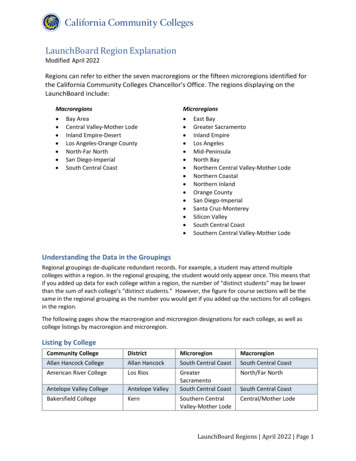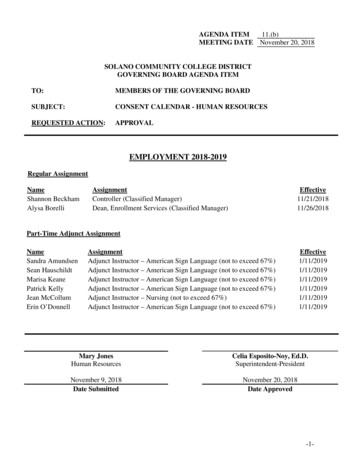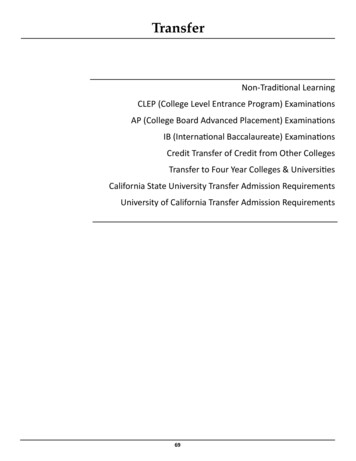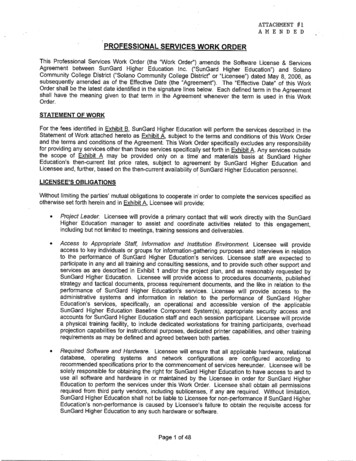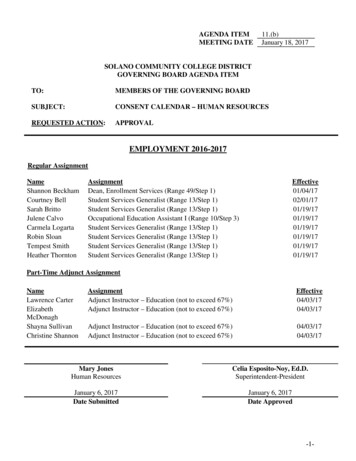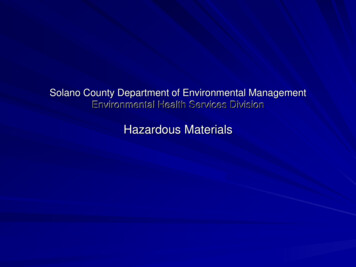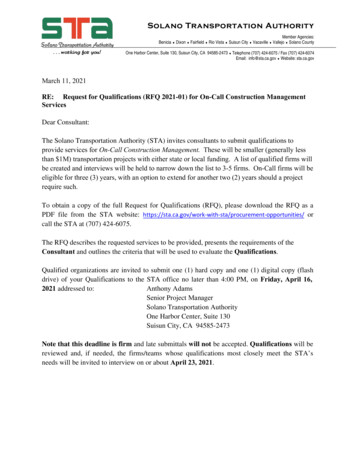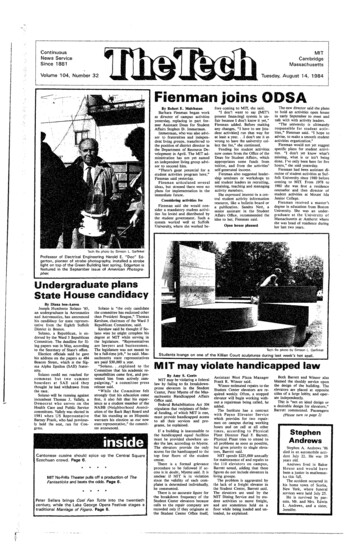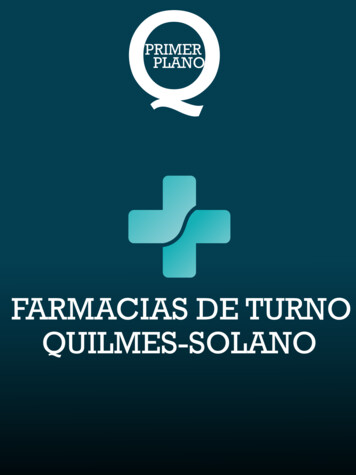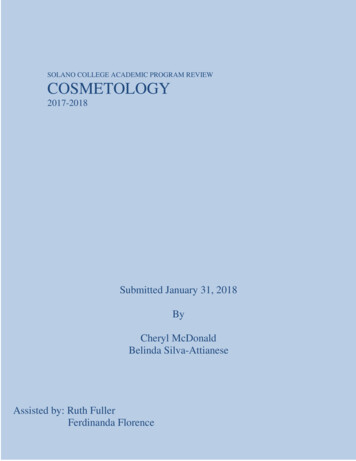
Transcription
HSOLANO COLLEGE ACADEMIC PROGRAM REVIEWCOSMETOLOGY2017-2018Submitted January 31, 2018ByCheryl McDonaldBelinda Silva-AttianeseAssisted by: Ruth FullerFerdinanda Florence
Assessment Schedule (adopted November, 2017)The following assessment schedule outlines in which year program reviews, curriculum reviews, and student &program learning assessments take place.Year 1: Program ReviewYear 2: SLO AssessmentYear 3: Curriculum ReviewYear 4: PLO AssessmentYear 5: SLO AssessmentYear 6: Preparation for Program Review*If it is the first time a course is taught, the SLO must be assessed that semester.School of Applied Technology and Business2016-2017 – SLO and PLO Assessments2017-2018 – Program Review2018-2019 – SLO Assessments2019-2020 – PLO Assessments Abridged Program Review (CTE)2020-2021 – Curriculum Review2021-2022 – SLO Assessment Abridged Program Review (CTE)School of Health Sciences & Counseling2016-2017 – SLO Assessments2017-2018 – SLO Assessments Abridged Program Reviews (CTE)2018-2019 – SLO and PLO Assessments2019-2020 – Program Review2020-2021 – SLO Assessments2021-2022 –Curriculum Review Abridged Program ReviewSchool of Social & Behavioral Sciences2015-2016 – Curriculum Review2016-2017 – SLO Assessments2017-2018 –SLO Assessments Abridged Program Review2018-2019 – SLO and PLO Assessments2019-2020 – Program Review2020-2021 – SLO Assessments2021-2022 – Curriculum Review Abridged Program Review (CTE)School of Math & Sciences2015-2016 – Curriculum Review (1st half), Program Review (2nd half)2016-2017 –SLO Assessments (1st half), Curriculum Review (2nd half)2017-2018 – SLO Assessments2018-2019 – SLO and PLO Assessments Abridged Program Reviews (CTE)2019-2020 – Any outstanding PLO/SLO assessments2020-2021 – Program Review (all)2021-2022 – SLO AssessmentsSchool of Liberal Arts and Library2015-2016 – Program Review2016-2017 – SLO Assessment2017-2018 – Curriculum Review Abridged Program Reviews (CTE)2018-2019 – SLO Assessments2019-2020 – PLO Assessments Abridged Program Reviews (CTE)2020-2021 – Any outstanding SLO/PLO Assessments2021-2022 – Program Review2
CONTENTSProgram Overview & ---------------------------Campus & Community -------Student Equity & oals & -------------------------Signature ---------Appendix A: Catalog Course Descriptions, 2017-18Appendix B: Minutes from Advisory Committee Meetings 2015-2017Appendix C: Supporting DocumentsAppendix D: Library Collection AssessmentAppendix E: Standard Program Review Survey3
PROGRAM OVERVIEW & MISSION1.1 Introduction. Introduce the program. Include the program’s catalogue description, itsmission, the degrees and certificates offered (including the courses required for the degrees).Include the names of full-time faculty, adjunct faculty, and classified staff. Give a brief history ofthe program and discuss any recent changes to the program or degrees (Limit to 2-3 pages).Cosmetology is one the founding programs of the college (1945). The following 2017-18program catalog description is out of date. Changes to the entire Cosmetology Program(certificate and the associate’s degree) and courses were made through the SCC curriculumapproval process during the 2017 Fall Semester. Upon approval by SCC the curriculum was4
submitted to the BACCC and the Chancellor’s Office and we are still awaiting their approvals.The specifics of the changes will be discussed in Section 3.Our mission is to prepare students to qualify for the cosmetology examination for licensure withthe California State Board of Cosmetology. Our main location is the 1600 building, room 1610.Our full time faculty include Belinda Silva-Attianese and Cheryl McDonald. Adjunct Faculty:Curley Miller-Wikkling, Patricia Barnes and Shaunice Cole. Support staff includes BarbaraGravely and Maria Miranda.1.2 Relationship to College Mission. Describe two or three components of your program thatembody the college’s mission: “Solano Community College’s mission is to educate a culturallyand academically diverse student population drawn from our local communities and beyond. Weare committed to helping our students achieve their educational, professional, and personal goals.Solano transforms students’ lives with undergraduate education, transfer courses, career-andtechnical education, certificate programs, workforce development and training, basic-skillseducation, and lifelong-learning opportunities.” (Limit to 1-2 paragraphs)The Cosmetology Program offers students a state-of-the-arts education in all aspects ofcosmetology. Upon completion of our program, students are able to apply for licensure as acosmetologist, and upon qualification, we work with students to ensure employment placementin the community.1.3 Enrollment. Utilizing data from Institutional Research and Planning (ITRP), analyzeenrollment data. In table format, include the number of sections offered, headcounts, and the fulltime equivalent enrollment (FTES) for each semester since the last program review cycle. If datais available for the number of declared majors in the discipline, please include as well. Comparethe enrollment pattern to that of the college as a whole and explain some of the possible causalreasons for any identified trends. For baccalaureate programs, include any upper division generaleducation courses as part of the analysis. Also, address the efficacy of recruitment and studentplacement in the program including any collaborations with other colleges.The cosmetology program has undergone substantional changes in how the program isscheduled. Prior to 2016 the program offered all courses, Cosme 100, 101,102, 103A and 103Bduring both the fall and spring semesters. This scheduling method was based on 27.5 contacthours per week, requiring a minimum of 2 years in which to complete the program. In an effortto enable students to complete the program sooner, the scheduling has been changed to 42.5contact hours per week requiring a minimum of 2 semesters and a summer school. Thescheduling of when the courses are offered has also changed to being offered sequentially: eg.Fall Cosme 100, Spring Cosme 101, Summer Cosme 102. Cosme106 was developed to enablestudents to complete lab hours they may have missed. The change from offering multiple courseofferings to a single course offering per semester has had a tremendious impact on all areas ofcosmetology: Enrollment, Headcount, FTES, Fill-Rate, WSH, Completion Rate, StudentPopulation, faculty, and adjunct faculty to name a few. Hence, the decling rates on the datacharts.5
Recruiting students continues to be difficult for cosmetology and all career and technicaleducation programs. The college does not clearly nor specifically promote each career programthat is offered when campagning to promote enrollments. Previously, funds were specificallyallocated to cosmetology for student recruitment; this is no longer the case. Despite the lack ofcollege efficacy for recruitment, student enrollments remain steady and job placement remainsvery good.Note on the charts below that the number of sections, headcount, and FTES have remainedrelatively steady over the past two years. The data mirrors drops in FTES college-wide.6
Data shows, again, a consistent number of majors in Cosmetology over the past two years. Also,the data shows a small number of business majors. This is a positive trend, one that weencourage. We inform students of the opportunities that available when students double-majorin Cosmetology and Business.1.4 Population Served. Utilizing data obtained from Institutional Research and Planning, analyzethe population served by the program (gender, age, and ethnicity) and discuss any trends indemographic enrollment since the last program review. Explain possible causal reasons for thesetrends, and discuss any actions taken by the program to recruit underrepresented groups.The cosmetology profession as a whole continues to be predominately female. There has been a5% increase of male students during the past two years. The department faculty work with otherdepartments, including Photography and Theater, in order to reach out to more gender-balancedpopulations. Statewide, barbers (who are predominately male) have begun to complete crossoverprograms to become cosmetologists as well. Conversely, barbers have been reaching out to ourfemale students, encouraging them to consider crossing over their training to master barberingskills.Student population of ethnicity continues to be a diverse combination. The dominate age groupsare 17 to 20 and 20 to 25 years old. There has been a substantial decrease in students 30 to 407
years old, combined with an increase in younger students (17-20). It is always advantageous tohave some older students in the class.8
1.5 Status of Progress toward Previous Goals and Recommendations. Report on the status ofgoals or recommendations identified in the previous program review or in the most recentupdate. (Please ensure your goals are updated at least yearly.) For status, note if completed,suspended, in progress, or now part of routine department activities. In-progress goals should beadded to Table 4.Table 1. Status of Previous Goals (from 2014 Program Review Report)Program GoalsOtherOtherAssessment GoalsAssessment is up-to-date andongoing; no goals at this timeCurriculum GoalsReview/change courseschedulingReview/change coursescheduling9Planned Action (s)Department Expansion- CompleteproposalsEsthetics Program-EveningProgramPlanned Action (s)Planned Action (s)Evening Program-Scheduling ofCosmo 101,102,103A&B classEvening Program-Scheduling ofCosmo 100 classStatusIn-progressNo longer valid. Programdiscontinued.StatusStatusIn-progress.See Section 3.Discontinued
Review/change courseschedulingCampus & CommunityIntegration/Outreach GoalsCurrent integration/outreachefforts are effective; no goals atthis timeStudent Equity & SuccessGoalsData shows student success andequity across all modalities anddemographics; no goals at thistimeProfessional DevelopmentGoalsDevelopment in subject areaYear Round Class- ConsistentScheduling of summer classPlanned Action (s)Human Resources GoalsAdd/replace full time positionPlanned Action (s)Replacement of our fulltimeFacultyAdd/replace/change staffpositionReplacement of our fulltimeClassifiedAdd/replace/change staffpositionReceptionist Program-Partime-20hours a week (someone at frontdesk)Technology & EquipmentGoalsTechnology and equipment areup-to-date; no goals at this timePlanned Action (s)StatusPlanned Action (s)StatusPlanned Action (s)Facilities GoalsPlanned Action (s)Add/upgrade instructional space We need a Cosmetology Buildingand Facility that is large enough toaccommodate enrollment and meetADA compliance codes, fire,electrical and other safetyrequirements!Library Resource GoalsPlanned Action (s)Add/update library resources10In-progressSee Section 3.StatusStatusContinues to be a concern,but position remainsunfilled; see Section 6.1,Human ResourcesPosition is temporarily filledbut not replaced with a fulltime permanent positionContinues to be a concern,but position remainsunfilled; see Section 6.1,Human ResourcesStatusStatusThe new CTE building isnot, to our knowledge, inMeasure Q plans; upgradesto the 1600 building needed(see Section 6.3, Facilities)Status
Other Resource GoalsPlanned Action (s)Status1.6 Previous Program Review Goals Leading to Improvement. Describe any improvements thatwere made to the program based on the previous program review goals. Include any availabledata/evidence about how those improvements had a positive impact on student access and/orstudent success.Guest Vision, a desk and reception business computer software system, was implemented duringspring 2018. The college IT department installed the system and worked with faculty and staffon the specifics of the installation. Full time faculty and support staff attended an on-sitetraining headed by the Guest Vision Regional Educator. The system has had a number ofglitches and complications. It is being utilized at the front desk reception area for schedulingclient services and completing daily business transactions. Students are utilizing the finger scanaspect for attendance accounting. Although it has been difficult to train students on the GuestVision system, overall it has been a very positive addition.Before implementation of the new system, students were scheduling all appointments by hand.They were not learning necessary business skills. Support staff were doing manual inventory,again not serving student learning needs.As a response to previous curriculum goals, the entire cosmetology program, scheduling andcourse content has been revised. This has had both a positive and negative impact on theprogram. As noted above, students now have the opportunity to complete the program within 2semesters and 1 summer. Access into the program is now limited to once a year, only during thefall semester.1.7 Future Outlook. Describe both internal and external conditions expected to affect the futureof the program in the coming years. Include labor market data as relevant for CTE programs.The California Labor Market website allows employment projections by occupation at the stateand county level: http://www.labormarketinfo.edd.ca.gov/ “Cal-PASS Plus offers longitudinaldata charts, detailed analysis of pre-K through 16 transitions and workplace outcomes,information and artifacts on success factors, and comparisons among like universities, colleges,K-12 school systems and schools”: https://www.calpassplus.org/ . (Limit to one page or less.)The cosmetology industry is expected to continue to thrive. The job outlook for cosmetologistsis exceptional! In California a cosmetologist license enables graduates to work as a manicurist,pedicurist, shampooer, skin care specialist, and makeup artist (theatrical/performance).What is not addressed in the OES Data Tables is the business employment opportunities: selfemployment as a booth renter, salon owner, salon manager, corporate franchisee, educator in aschool, product distributor, district and regional corporate managers, product trainer anddemonstrator.Following is the OES Employment and Wages Data Table for the first quarter of 2016:11
Source: State of CA Employment Development ata/oes-employment-and-wages.html#ToolFollowing is the Projection of Employment by Occupation, 2014-2024, California EmploymentDevelopment a.gov/commcolleges/Projections.aspCareer Technical Education Planning(Non-CTE program proceed to Section 2, Assessment.)1.8 Advisory Boards/Licensing (if applicable). Describe how program planning has beeninfluenced by advisory board/licensing feedback. How often are advisory board meetings held,provide membership information and what specific actions have been taken. Attach minutesfrom the past two years in an appendix.The cosmetology advisory board meets bi-annually. For minutes, please see Appendix B.Our advisory committee includes diverse professionals: regional franchise owners of SportsClips, Cost Cutters, Great Clips, and Supercuts. We also have salon owners, including GinaKahn from San Francisco, and Nicholas from San Francisco, both well-renowned in the industry.The committee includes also several graduates and managers, including the manager from JCPenney, Fairfield, and an alumni who is the manager of Ulta in Fairfield.The committee influenced the curriculum decisions noted above, and they also participate withour curriculum by coming in and doing demonstrations and educational classes on haircutting,coloring, business practices, etc.12
1.9 Core Indicator Report. Review the Perkins core indicator reports for your TOP code:https://misweb.cccco.edu/perkins/Core Indicator Reports/Summ coreIndi TOPCode.aspx .What are the areas of needed improvement? What efforts have you already made and/or plan tomake to support students in these areas? (Limit to 1-2 paragraphs)As the chart below indicates, there has been a problem with the methodology of the state’sreporting. The state’s report includes data on Cosmetology 100, 101, 102 and 103A and 103B;however, due to variable attendance and completion rates, enrollment numbers in these courseshas decreased with each subsequent course offering.Performance Rate Less Than Goal is ShadedTotal Count is 10 or GreaterTotal Count is Less Than 10Source:https://misweb.cccco.edu/perkins/Core Indicator Reports/Summ coreIndi TOPCode.aspx#P2e87d5c171724616bb8faf8c31a433bf 22 116iT0R6R0x4ASSESSMENTProgram Learning Outcomes2.1 PLOs and ILOs. Using the table provided, list the Program Learning Outcomes (PLOs) andwhich of the institutional learning outcomes (ILOs) they address. In the same table, specificallystate (in measurable terms) how your department assesses each PLO. State the course(s) andassignment(s) where the PLOs are measured. Additionally, please review the PLOs in the collegecatalogue to ensure they are accurate. If they are not, be sure to add as a goal (Table 4) plans tochange PLOs in CurriCUNET and contact the curriculum office to ensure they are updated in thecatalogue.PLOs and SLOs are in the process of revision as part of the cosmetology program pending theBACCC and Chancellor’s Office approvals. We are currently waiting to complete the approvalprocess. Table 2a-1 shows the previous PLOs, the ones that are currently published. Table 2a-2shows the new PLO, awaiting approval. This is a single PLO, tied to students’ success inobtaining licensing.13
Table 2a-1. Program Learning Outcomes (as published)Program Learning Outcomes1. Students will contrast andcompare the skills andconcepts as required by theCalifornia State Board ofBarbering And Cosmetology2. Students will interpret andapply cosmological theoriesas required for theoreticaland practical applications.3. Students will translate andidentify the differencesbetween chemical and nonchemical changes as relatedto Cosmetology.4. Students will completemandated laboratory hoursand operations; Desk andReception; Business andCommunication skills; Salesand Retail productknowledge.ILO(I A,B; II D;IIIB,C)How PLO is assessedScore of 75% or higher onWritten Final MultipleQuestion Test in Cosmo100(ID; IIA; III C; IIIIC)Score of 75% or higher ona simulated State BoardMini-Board exam.Practical Test in Cosmo103Score of 75% or higher onMidterm Practical inCosmo 102(IIB; IIIIA,C)(IA,B; IIA;IIIA;III C)Score of 75% or higher ontheir portfolio project inCosmo 101Table 2a-2. Program Learning Outcomes (pending approval)Program Learning Outcomes1. Meet the minimumrequirements to makeapplication to take theCalifornia State Board ofCosmetology examination forcosmetology licensingILO(I A,B; II D;IIIB,C)How PLO is assessedPassing cosmetologyexamination2.2 PLO Mapping. Report on how courses support the Program Learning Outcomes at whichlevel (introduced (I), developing (D), or mastered (M)).The table below reflects the PLOs mapping for the old outcomes. The department will revisit themapping in the next cycle with CurricUNET Meta.Table 2b. Program Courses and Program Learning Outcomes14
List the Course and SLO that maps to thePLOCOSM 100COSM 101COSM 102PLO 1IDDPLO 2IDDPLO 3IDDPLO 4IID2.3 PLO Results and Planned Actions. Utilizing Table 2c, summarize the results of programlearning assessments and any planned actions to increase student success where deficits werenoted. Results should be both quantitative and qualitative in nature, describing student strengthsand areas of needed improvement. Action plans should be specific and link to Table 4 (goals) aswell as any needed resources (Section 7.2) to achieve desired results. (If PLO Assessments areextensive, then make a note here and use Table 2c as an Appendix.) Then, in Table 2d, completethe assessment calendar.Table 2c. Program Learning Outcomes Assessments (omitted)The new PLO has not been assessed because we are waiting for approval of the proposedcosmetology program by the BACCC and the Chancellor’s Office. There is no recorded PLOassessment by the department; the faculty will complete a PLO assessment in CurricUNET Metain the next cycle.15
Table 2d. PLO Assessment CalendarFaculty typically choose to assess all the PLOs during the same academic year. Please mark theyear they will take place (refer to the assessment schedule, p. 2).F17S18F18PLO1S19F19xS20xF20S21F21S222.4 PLOs Leading to Improvements. Describe any changes made to the program or courses thatwere a direct result of program learning outcomes assessments.N/AStudent Learning Outcomes2.5 SLOs Status. Describe the current status of SLOs in your program. If deficiencies are noted,describe planned actions for change and include these in your goals (Table 4). Are there 2-4 measurable SLOs for each course in your discipline? Have success criteria rubrics been created to standardize the evaluation of studentsuccess? Have faculty assessed the Student Learning Outcomes according to the publishedAssessment calendar (at least twice in a program review cycle)? You may wish toinclude a SLO assessment calendar for each course in the discipline (Table 3);move to appendix if lengthy. Do the assessments follow the guidelines for qualityoutlined in the SLO Quality Assessment Rubric? Have faculty engaged in discussions about SLOs, success criteria, and theirassessments as they relate to the improvement of student success and thechallenges students face? Have faculty disaggregated any of the assessment results to show specific areas ofneed in the classroom (for example, commonalities among students who are lessor more successful such as attendance, use or lack of use of student supportservices, proficiency or difficulty with writing, role overload or other stressorsoutside of school, etc.)? If deficiencies are noted in any of the above areas, describe planned actions forchange.Both full-time and part-time faculty have regularly assessed their SLOs, as required in thetwo-year cycle. The new SLOs have not been assessed because we are waiting for theapproval of the BACCC and the Chancellor’s Office. The department received a waiverfrom the Assessment Coordinator to delay inputting SLOs in CurricUNET Meta until thechanges take effect.Faculty use a common rubric to ensure standard assessment. Rubrics are housed in ISHTAR,the department server. Faculty meet to review SLOs and student assessments.16
2.6 SLOs Leading to Improvements. Describe any changes made to the program or courses thatwere a direct result of student learning outcomes assessments.Based on SLO assessments, faculty discovered that students were being exposed to businessfundamentals too early in the program, and they weren’t retaining their knowledge (how to runand manage a business) by the time they had completed the program. A lot of students wanted tobecome salon owners, but the gap between the second and fourth semesters impaired theirpreparation. To fix this problem, rather than have students complete the business fundamentalsportion of the course in the second semester of the program, in 101, we are now having studentsdo that component in 102, just before they are ready to complete the program.General Education & Institutional Learning Outcomes2.7 GELOs and ILOs. Review any general education courses offered by your program to ensurethey are accurately linked with the appropriate general education learning outcome (GELO) inthe CurriCUNET assessment module, and that the GELO is measurable in the SLO(s) of thecourse. Then review all courses and their SLOs in CurriCUNET to ensure they are accuratelylinked with the appropriate institutional learning outcomes (ILOs), and that they are measurable.In most cases there will only be one GELO and/or one ILO link per SLO. Report on changes thatneed to be made in order to effectively integrate GELOs and ILOs into instruction.The cosmetology courses do not count for general education. When the course SLOs areinputted in CurricUNET Meta, they will be mapped to ILOs.CURRICULUM3.1 Course offerings. Attach a copy of the course descriptions from the most current catalogue.For catalog course descriptions, 2017-18, see Appendix A.Describe any changes to the course offering since the last program review cycle (course content,methods of instruction, etc.) and provide rationale for deletion or addition of new courseofferings. If there are courses in the catalogue that haven’t been offered in the past two years,state the course(s) and note the reason(s) they haven’t been offered (no faculty to teach, lowenrollment, etc.). State the plans for either offering or inactivating/deleting these courses. Alsostate whether any new degrees of certificates have been created and the rationale for doing so.For baccalaureate programs, include any upper division general education courses as part of thereport.As noted above, many changes were made to courses, course sequencing, and thedegree/certificate. Within courses, changes were made to be more modular. Prior to the changes,each course outline included a variety of skills and subjects, and with each course, studentswould add onto those skills. Now, each course has a more focused set of skills/subjects, whilestudents continue to build on skills learned in previous courses. For example, students in 100will learn hair removal by tweezing, and in 101, they will learn hair removal by waxing (hard17
and soft). The department has not yet determined whether these changes have resulted in studentsuccess.3.2 Scheduling and Sequencing. Discuss efforts to optimize access through scheduling. Howhave faculty (in collaboration with deans) planned the timing, location, and modality of courses?Report on whether courses have been sequenced for student’s timely progression through themajor, how students are informed of this progression, and the efficacy of this sequencing. Reporton whether curriculum is being offered in a reasonable time frame and if there are plans/goals forscheduling changes. (Limit to 1-2 paragraphs)As the chart below shows, starting in Fall 2016, Cosme 100 was only offered in the Fall. Theplan was to have students begin their progress through the program in Cosme 100, then in Springtake Cosme 101, and complete in the summer taking 102. However, because of schedulingproblems, students entering in Fall 2015 were unable to get enough contact hours to finish theprogram within the new program timeline model. As a result, many students fell behind, with asmuch as 40 contact hours missing from their required schedule. These students had to make upthis time somehow, which resulted in a difficult scheduling scenario with the Banner enrollmentsystem. This problem continues to reverberate for our current students. Students needing twoextra units, for example, have taken Cosme 103B, a six-unit course, because they had no otheroptions. In the near future, however, students will have a variable-unit option with a new course,Cosme 106, which does not yet appear in the catalog.18
The sequencing chart shows that all students currently take COSM 100 first, then 101, then 102,and so on. In the future, students will start with Cosme 100 in the Fall, then take 101 in theSpring, 102 in the summer, and if needed, 106 in the following Fall. However, 106 is not part ofthe program.3.3 Student Survey. Describe the student survey feedback related to course offerings. In terms ofthe timing, course offerings, and instructional format, how does what your program currentlyoffer compare to student responses? Please include the student survey and any relevant charts asan appendix.3.4 Fill rates/Class size. Based on data from ITRP, discuss the trends in course fill rates andpossible causes for these trends (include comparison/analysis of courses by modality ifapplicable). Address how the size of classes affects courses and if there are any necessaryadjustments to course classroom maximums. If there are courses that are historically underenrolled, discuss strategies that might increase enrollment. (Limit to 1-2 paragraphs)The chart below shows fill rates in the face-to-face classes in the 1600 building. There are noonline courses in Cosmetology. Most classes average 80% or higher fill. Faculty have beenaccepting students over the class maximum in an effort to ensure the continued health andsuccess of the program. If students cannot get into the courses they need, the entire program is injeopardy. When faculty have more students than they can handle, this can negatively impactlearning. For example, if a class has more than 25 students, then it will have more than 25clients as well, with a total of more than 50 people in the classroom at a time. This presents bothsafety and health issues. However, faculty are also concerned about retention. If 30 studentsbegin the program in the Fall, some may drop due to unforeseen circumstances, and the numberof students in the program will get smaller each semester. Keeping this inevitable trend in mind,19
faculty would like to accommodate as many students as possible in Cosme 100, but are simplyunable to do so, due to the size of the facility and staffing.3.5 Four-year articulation (if applicable). Utilizing the most current data from the articulationofficer, and tools such as ASSIST.org, state which of your courses articulate with the local fouryear institutions and whethe
the program and discuss any recent changes to the program or degrees (Limit to 2-3 pages). Cosmetology is one the founding programs of the college (1945). The following 2017-18 program catalog description is out of date. Changes to the entire Cosmetology Program
